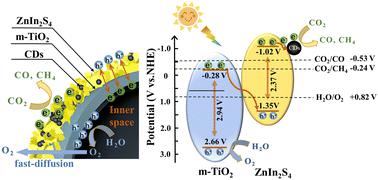当前位置:
X-MOL 学术
›
J. Mater. Chem. A
›
论文详情
Our official English website, www.x-mol.net, welcomes your
feedback! (Note: you will need to create a separate account there.)
Self-assembly of a heterogeneous microreactor with carbon dots embedded in Ti-MOF derived ZnIn2S4/TiO2 microcapsules for efficient CO2 photoreduction
Journal of Materials Chemistry A ( IF 10.7 ) Pub Date : 2022-11-10 , DOI: 10.1039/d2ta07217c Dongxue Wu 1 , Qian Liang 1 , Honglin Si 2 , Xiong Yan 2 , Hui Huang 2 , Zhongyu Li 1 , Zhenhui Kang 2, 3, 4
Journal of Materials Chemistry A ( IF 10.7 ) Pub Date : 2022-11-10 , DOI: 10.1039/d2ta07217c Dongxue Wu 1 , Qian Liang 1 , Honglin Si 2 , Xiong Yan 2 , Hui Huang 2 , Zhongyu Li 1 , Zhenhui Kang 2, 3, 4
Affiliation

|
The assembly of the heterogeneous microreactor is a promising approach for CO2 photoreduction attributed to its abundant microchannel, intimate contact, high exposed surface area, and favorable heat-mass transfer. Herein, we developed a metal–organic framework (MOF) derived in situ transformation strategy to construct a carbon dot (CD)-decorated ZnIn2S4/TiO2 (CDs/ZIS/TiO2) microreactor. Taking advantages of this hierarchical structure, the CDs/ZnIn2S4/TiO2 microreactor exhibits significantly enhanced photocatalytic CO2 reduction activity with a CH4 yield of 14.9 μmol g−1 h−1 and CH4 selectivity of 75.6% in the absence of a sacrificial agent, where the electron consumption rate (Relectron) of 157.6 μmol g−1 h−1 is 1.9 and 18.3 times higher than those of ZIS(60)/TiO2 and bare ZnIn2S4, respectively. The combination of transient photo-induced voltage (TPV), in situ Fourier transform infrared and electron spin resonance (ESR) spectra illustrate the photocatalytic mechanism and the effect of CDs on the electron transfer behavior. This work emphasizes a facile technique for developing a CD-based microreactor to achieve high-efficiency photocatalytic CO2 reduction performance.
中文翻译:

在 Ti-MOF 衍生的 ZnIn2S4/TiO2 微胶囊中嵌入碳点的非均相微反应器的自组装用于高效的 CO2 光还原
非均相微反应器的组装是一种很有前途的CO 2光还原方法,这归因于其丰富的微通道、紧密的接触、高暴露表面积和良好的传热。在此,我们开发了一种金属有机骨架(MOF)衍生的原位转化策略来构建碳点(CD)装饰的ZnIn 2 S 4 /TiO 2(CDs/ZIS/TiO 2)微反应器。利用这种分层结构,CDs/ZnIn 2 S 4 /TiO 2微反应器表现出显着增强的 CH 4光催化 CO 2还原活性在没有牺牲剂的情况下,产率 14.9 μmol g -1 h -1和 75.6% 的 CH 4选择性,其中157.6 μmol g -1 h -1的电子消耗率( R电子)分别是 1.9 和 18.3 倍分别为ZIS(60)/TiO 2和裸ZnIn 2 S 4。瞬态光感应电压 (TPV)的原位组合傅里叶变换红外和电子自旋共振 (ESR) 光谱说明了光催化机制和 CD 对电子转移行为的影响。这项工作强调了一种开发基于 CD 的微反应器以实现高效光催化 CO 2还原性能的简便技术。
更新日期:2022-11-10
中文翻译:

在 Ti-MOF 衍生的 ZnIn2S4/TiO2 微胶囊中嵌入碳点的非均相微反应器的自组装用于高效的 CO2 光还原
非均相微反应器的组装是一种很有前途的CO 2光还原方法,这归因于其丰富的微通道、紧密的接触、高暴露表面积和良好的传热。在此,我们开发了一种金属有机骨架(MOF)衍生的原位转化策略来构建碳点(CD)装饰的ZnIn 2 S 4 /TiO 2(CDs/ZIS/TiO 2)微反应器。利用这种分层结构,CDs/ZnIn 2 S 4 /TiO 2微反应器表现出显着增强的 CH 4光催化 CO 2还原活性在没有牺牲剂的情况下,产率 14.9 μmol g -1 h -1和 75.6% 的 CH 4选择性,其中157.6 μmol g -1 h -1的电子消耗率( R电子)分别是 1.9 和 18.3 倍分别为ZIS(60)/TiO 2和裸ZnIn 2 S 4。瞬态光感应电压 (TPV)的原位组合傅里叶变换红外和电子自旋共振 (ESR) 光谱说明了光催化机制和 CD 对电子转移行为的影响。这项工作强调了一种开发基于 CD 的微反应器以实现高效光催化 CO 2还原性能的简便技术。











































 京公网安备 11010802027423号
京公网安备 11010802027423号